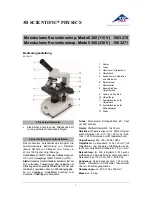
6
MAINTENANCE
WARNING: For your own safety, turn switch off and remove recharger from power source before
maintaining your microscope. If the power cord is worn, cut or damaged in any way, have it replaced
immediately to avoid shock or fire hazard.
1. OPTICAL MAINTENANCE
A. Do not attempt to disassemble any lens components. Consult a microscope service technician
when any repairs not covered by instructions are needed.
B. Prior to cleaning any lens surface, brush dust or lint off lens surface using a camel hairbrush. You
can also use an ear syringe or canned compressed air, such as that sold by most computer
stores.
C. Do not remove eyepieces or objective lenses to clean. Clean only the outer lens surface. Breath
on lens to dampen surface, then wipe with lens paper, or use a cotton swab moistened with
distilled water. Wipe lenses with a circular motion, applying as little pressure as possible. Avoid
wiping dry lens surface as lenses are scratched easily. If excessive dirt or grease gets on lens
surfaces, a small amount of Windex can be used on a cotton swab or lens tissue. To clean
objective lenses, do not remove objectives from microscope. Clean front lens element only,
following same procedure.
NOTE: Fingerprints or other matter on the front lens element of the objective lens is the single
most common reason that you will have difficulty in focusing the microscope. Before having costly
servicing done, or before returning to National for “warranty repair”, make certain to examine the
front lens element with a magnifying glass or eye loupe for the presence of such contaminants. If
a microscope is returned for warranty repair, and it is determined that such contaminants are the
problem, this is not covered under warranty and National will submit a cost estimate for cleaning.
2. MECHANICAL MAINTENANCE
A. The rack stop screw has been pre-adjusted at the factory and should not require re-adjustment.
B. Metal parts: Use a clean, damp cloth to remove dust or dirt from metal parts, followed by a dry
cloth.
3. ELECTRICAL MAINTENANCE
The extent of electrical maintenance, by other than a qualified technician, should be LED lamp
replacement, battery recharging and battery replacement. Before maintenance, be sure that
recharger is not connected to microscope.
A. Recharging batteries: Plug output cord from battery charger into DC recharging socket located on
back of microscope base. Your automatic switching recharger operates on 100 to 240 volts AC
50/60 Hz, plug recharger into your AC wall outlet. The red LED indicator lamp located on
recharger will be illuminated when batteries are receiving maximum charge. After batteries are
charged, the red LED indicator lamp will turn to green and charger automatically switches to
“trickle charge”. The charger can be left plugged in, but for safety reasons it is a good idea to
disconnect the charger from the AC wall outlet and the output cord from recharging socket after
12 hours. Batteries and charger may feel warm when charging, and unplugging the recharger is a
safety precaution. You may operate the microscope light even while it is being recharged. Simply
continue to use the microscope while the recharger is fully engaged.





















